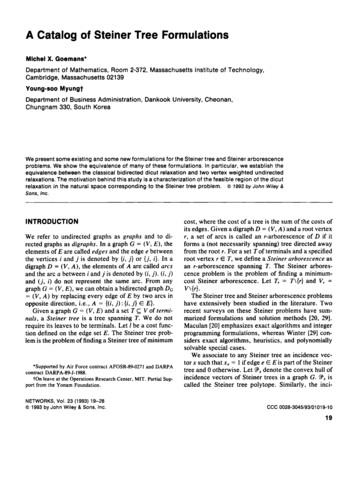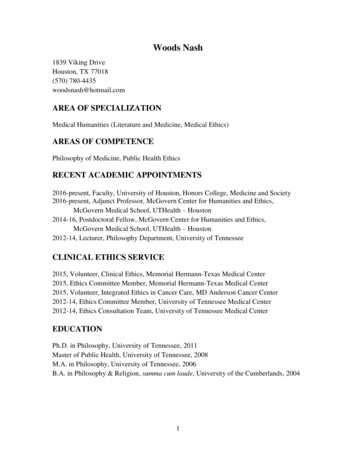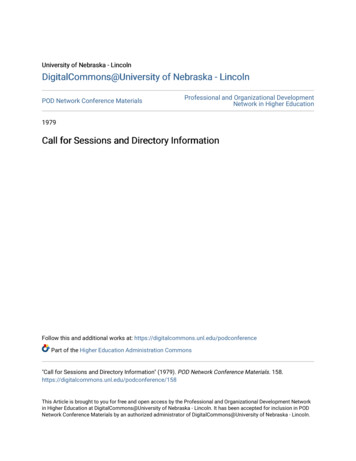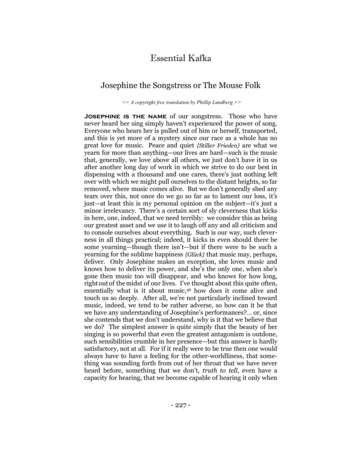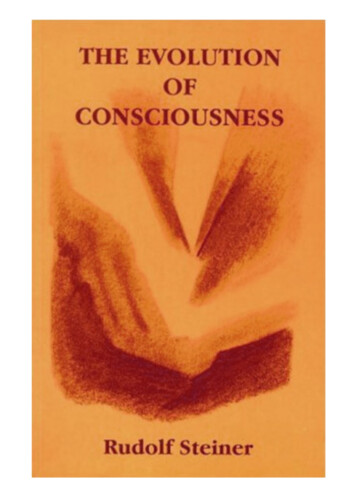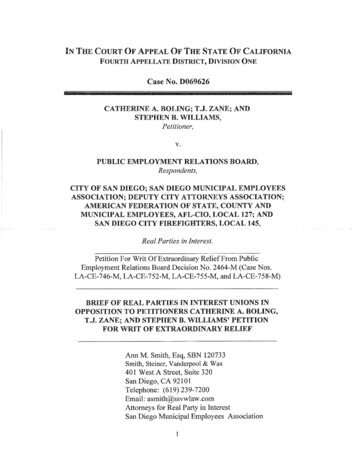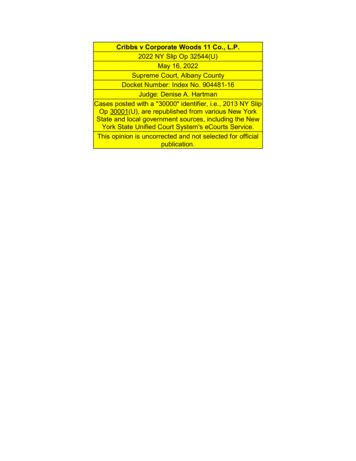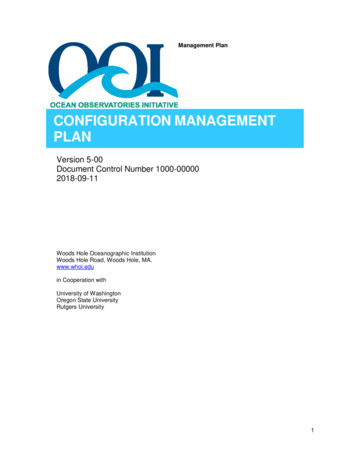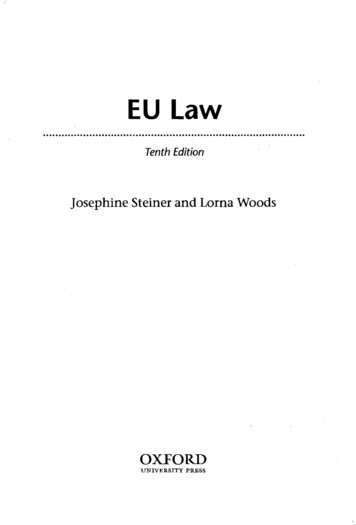
Transcription
EU �·· ···· ············ ·············Tenth EditionJosephine Steiner and Lorna WoodsOXFORDUNIVERSITY PRESS
OXFORDUNIVERSITY PRESSGreat Clarendon Street, Oxford oxZ 6dpOxford University Press is a department of the University of Oxford.It furthers the University's objective of excellence in research, scholarship,and education by publishing worldwide inOxford New YorkAuckland Cape Town Dar es Salaam Hong Kong KarachiKuala Lumpur Madrid Melbourne Mexico City NairobiNew Delhi Shanghai Taipei TorontoWith offices inArgentina Austria Brazil Chile Czech Republic France GreeceGuatemala Hungary Italy Japan Poland Portugal SingaporeSouth Korea Switzerland Thailand Turkey Ukraine VietnamOxford is a registered trade mark of Oxford University Pressin the UK and in certain other countriesPublished in the United Statesby Oxford University Press Inc., New York josephine Steiner and Lama Woods, 2009The moral rights of the authors have been assertedDatabase right Oxford University Press (maker)Crown copyright material is reproduced under Class LicenceNumber C01P(X)()0148 with the permission of OPSIand the Queen's Printer for ScotlandTenth edition 2009All rights reserved. No part of this publication may be reproduced,stored in a retrieval system, or transmitted, in any form or by any means,without the prior permission in writing of Oxford University Press,or as expressly permitted by law, or under terms agreed with the appropriatereprographics rights organization. Enquirtes concerning reproductionoutside the scope of the above should be sent to the Rights Department,Oxford University Press, at the address aboveYou must not circulate this book in any other binding or coverand you must impose this same condition on any acquirerBritish Library Cataloguing in Publication DataData availableLibrary of Congress Cataloging in Publication DataData availableTypeset by MacMillan Publishing SolutionsPrinted in Great Britainon acid-free paper byAshford Colour Press Ltd, Gosport, HantsISBN 978-0-19-921907-013579108642
GUIDE TO USING THE ONLINE RESOURCE CENTREThe Qri!l! f R source Centre that'accompaDi s t):lis book provides' JtUdell,t 'ij"tl!lleCtUrers with ready'o:·: ,o 4.se. a(:p t:ri.g and learning resources.I· For StudentsFreely available 'tQ all with no registration or password required.monitor allows you to explore the background to this potentially vital newreform of EU law and follow its ratification process.Regular updatesFlashcard glossaryA vital resource allowing you to followthe changes and developments to EU lawthat have occurred since publication.Interactive flashcards containing keywords and terms allow you to test yourknowledge and understanding.Interactive timelineAllows you to trace the developments inEU legal history from the birth of the EUthrough to the present day. Ideal for students new to the subject and as a sourceof revision.Interactive map of EuropeProvides a useful summary of each ofthe Member States including essentialfacts and figures.Video clipsArchive footage from the EuropeanCommission showing key moments inthe development of the EU.Web linksAn guide to EU material on the internetallows you to take your learning furtherand research those important topics ofparticular interest.Lisbon Treaty ratification monitorProduced by the Bertelsmann Foundation, the Lisbon Treaty ratificationFor LecturersPassword protected to ensure only lecturers can access these resources; eachregistration is personally checked to ensure security of the site.Registration is straightforward: clickon 'Lecturer Resources' on the OnlineResource Centre, complete a simpleregistration form which allows you tochoose your own username and password, and access will be granted within48 hours (subject to verification).Test bankA fully customisable resource containing ready-made assessments with whichto test your students. Offers versatiletesting tailored to the contents of thetextbook.Figures and diagramsElectronic copies of the figures from thebook are available for use in lectures andhandouts.
OUTLINE CONTENTSPART I1From EEC to EU: A brief history of the development of the Union32Institutions of the Union: Composition and powers253Scope of the EC Treaty: Laws and lawmaking514Principle of supremacy of EC law855Principles of direct applicability and direct effects1056General principles of law133PART 111677Framework for enforcement1698Remedies in national courts1799State liability20610 The preliminary rulings procedure22211 Enforcement actions25512 Direct action for annulment27513 Action for failure to act31114 Community liability in tort: Action for damages321PART Ill34315 Introduction to the internal market34516 Harmonisation36017 Free movement of payments and capital38518 Customs union39819 Free movement of goods41220 Derogation from the free movement of goods44221 Citizenship: Right of free movement and residence45522 Economic rights: Workers, establishment, and services49123 Free movement: Social rights52924 Right to receive services55325 Free movement of persons: Limitations on groundsof public policy, public security, or public health565
Outline contents26 The area of freedom, security, and justice: EU homeaffairs law and policy57927 Discrimination60628 Introduction to competition policy65529 Element of competition law in the internal market66430 Intellectual property rights and the internal market71331 Restrictions on State aid728vii
DETAILED CONTENTSxivPrefaceAbbreviationsTable of Cases -Chronological ListTable of Cases- Alphabetical ListTable of Commission DecisionsTable of UK StatutesTable of European Community TreatiesTable of EU Secondary LegislationTable of T I1From EEC to EU: A brief history of the development of the Union1.1 Introduction 31.2 Development prior to the Single1.7 Treaty of Nice 121.8 Treaty establishing a Constitutionfor Europe 141.9 Treaty of Lisbon 151.10 Theories of integration 191.31.41.51.6European Act 3Enlargement 4The Single European Act 6Treaty on European Union 7Impact of the Treaty ofAmsterdam 102Institutions of the Union: Composition and powers2.1 Introduction 252.2 The institutions 252.3 Parliament (Articles 189-201(ex 137-44) EC) 262.4 Council (Articles 202-10(ex 145-54) EC) 322.5 Commission (Articles 211-19(ex 155--63) EC) 372.6 Economic and Sodal Committee(Articles 257-62 (ex 193-8) EC) 4131.11 Conflicting attitudes towardsthe Union 211.12 The future 232.72.82.92.1025Committee of the Regions 41Budgetary procedures 42Court of Auditors 42Court of justice (Articles 220-45(ex 164-88) EC) 432.11 Lisbon Treaty 472.12 Conclusions 483Scope of the EC Treaty: Laws and lawmaking3.13.23.33.43.53.6Introduction 51Scope of the EC Treaty 51Basis for legislative action 56Expansion of Union competence 59Competence and subsidiarity 61Lawmaking process 643. 7 Legislative acts 703.8 Sources of EC law 753.9 Problems in the lawmakingprocess 763.10 Conclusions 8251
Detailed contents4Principle of supremacy of EC law4.1 Introduction 854.2 The problem of priorities 854.3 The Court of Justice'scontribution 8754.4 The Member States' response 934.5 Supremacy, the Constitution, andLisbon 1014.6 Conclusions 102Principles of direct applicability and direct effects5.1 Introduction 1055.2 Doctrine of direct effects 1056855.3 Prindple of indirect effects 1245.4 Conclusions 130General principles of law6.1 Introduction. J336.2 Rationale for the introduction ofgeneral principles of law 1346.3 Development of generalprinciples 1356.4 Relationship between the EC/EUand the ECHR in the protectionof human rights: View from theECHR 1411051336.5 The EU Charter of FundamentalRights 1436.6 Rules of administrative justice 1476.7 Equality 1566.8 Subsidiarity 1586.9 Effectiveness 1586.10 General principles applied to nationallegislation 1596.11 Conclusions 163PART 117Framework for enforcement7.1 Introduction 1697.2 Action before the EuropeanCourts 17087.3 Action before national courts 1747.4 Conclusions 177Remedies in national courts8.1 Introduction 1798.2 General principles regarding nationalprocedural rules 1808.3 Meaning of 'effectiveness' 1828.4 Principle of 'equivalence' 19391691798.5 Impact of EC law on nationalremedies 1958.6 Impact of treaty amendment 2028.7 Conclusions 202State liability9.1 Introduction 2069.2 Principle of state liability underFrancovich v Italy 20610 The preliminary rulings procedure10.1 Introduction 22210.2 The text of Article 234 and anoverview of the procedure 2232069.3 Conclusions 22022210.3 The generous approach of the ECJ toArticle 234 references 22510.4 The ECJ's refusal to give rulings insome cases 233ix
xDetailed contents10.5 National courts and the referenceprocedure 23710.6 What is the temporal effect of aruling from the ECJ? 24610.7 Special limits on references inJHA 24910.8 The increasing workload of the ECJ:The need for reform 25110.9 Conclusions 25211 Enforcement actions11.1 Introduction 25511.2 Outline of enforcementmechanism 25511.3 Purpose of enforcement actions 25711.4 Member States' failure to fulfil anobligation 25711.5 Procedure 25911.6 Defences 26311.7 Consequences of a ruling andof a failure to comply 26725511.8 Action by Member States(Article 227 EC) 27111.9 Impact of the treaty amendment 27211.10 Special enforcement procedures:State aid, breach of Article 95(4)procedures, and measures toprevent serious internaldisturbances 27311.11 Conclusions 27312 Direct action for annulment12.1 Introduction 27512.2 Overview of provisions 27612.3 Judicial review: Reviewable acts 27712.4 Locus standi: Who may bring anaction? 28012.5 Time limits 29827512.6 The merits 30012.7 Consequences of a successfulaction 30412.8 Scope of indirect review underArticle 241 EC 30612.9 Conclusions 30913 Action for failure to act13.1 Introduction 31113.2 Overview of the provisions 31113.3 Reviewable omissions 31213.4 Locus standi 31331113.5 Procedure 31713.6 Consequences of a successfulaction 31913.7 Conclusions 32014 Community liability in tort: Action for damages14.1 Introduction 32114.2 Scope of non-contractualliability 32114.3 Locus standi 32314.4 Elements of non-contractualliability 32414.5 Wrongful acts or omissions 32514.6 Establishing an unlawful act 32614.7 Liability for lawful acts 33232114.8 Damage 33314.9 Causation 33514.10 Impact of other possible causes ofaction 33614.11 Relationship between Article 288(2)and other remedies 33 714.12 Concurrent liability 33814.13 Conclusions 340PART Ill15 Introduction to the internal market15.1 Introduction 34515.2 Overview of the four freedoms 34615.3 Common themes in the freemovement provisions 350345
Detailed contents15.4 Relationship between thefreedoms 35515.5 The social dimension 35615.6 Completion of the internal marketand the position of third countrynationals 35716 Harmonisation16.1 Introduction 36016.2 The nature of harmonisation 36116.3 Types of harmonisation 36336016.4 Article 95 and harmonisation 37316.5 The impact of harmonisation ondomestic law 37916.6 Conclusions 38317 Free movement of payments and capital17.1 Introduction 38517.2 Outline of provisions relating to thefree movement of capital 38517.3 Scope of the free movement ofcapital 38617.4 Exceptions to the free movement ofcapital 39017.5 Relationship with other freedoms 39417.6 Restrictions on free movement ofcapital between Member Statesand third countries 39617.7 Power to legislate in the field of freemovement of capital 39617.8 Conclusions 39718 Customs union18.1 Introduction 39818.2 Common customs tariff 39918.3 Prohibition between MemberStates of customs duties on importsand exports and of all charges ofequivalent effect 39939818.4 Prohibition of discriminatorytaxation 40518.5 Harmonisation of indirecttaxation 41018.6 Conclusions 41119 Free movement of goods19.1 Introduction 41219.2 Outline of provisions 41319.3 Whose actions are caught? 41419.4 Types of act caught by Articles28-9 41719.5 Prohibition on quantitativerestrictions 41719.6 Prohibition on measures havingequivalent effect to quantitativerestrictions 41841219.7 Prohibition, as between MemberStates, of quantitative restrictions onexports and of all measures havingequivalent effect (Article 29) 43719.8 State monopolies 43819.9 Relationship with other treatyprovisions 44019.10 Conclusions 44020 Derogation from the free movement of goods20.1 Introduction 44220.2 Outline of Article 30 44220.3 Proportionality and disguisedrestriction on trade 44338520.4 Grounds for derogation 44420.5 Derogation provisions other thanArticle 30 EC 45220.6 Conclusions 453442xi
xiiDetailed contents21 Citizenship: Rights of free movement and residence21.121.221.321.4Introduction 455Overview of provisions 456Enforcement 458Personal scope: Who benefits? 45921.5 Material Scope: Rights of access ofthe host Member State (Directive2004/38/EC) 47821.6 Conclusions 48922 Economic rights: Workers, establishment, and services22.122.222.322.4Introduction 491Treaty provisions 492Right of access to the market 493Test for the application of Articles 39,43, and 49 EC 50022.5 Limitations on the application ofArticles 39, 43, and 49 507A Rule of reason? 508Harmonisation 512Professional qualifications 517Establishment, services 1 andcompanies 52122.10 Conclusions 52752923.4 Citizenship 54723.5 Citizenship directive 55123.6 Conclusions 55255324 Right to receive services24.1 Introduction 55324.2 General 55324.3 Non-discrimination and Unioncompetence 55524.4 Scope of services: Corollary to theright to receive 55724.5 Remuneration and the role of thestate 55824.6 Assessment of the position of publicservices under Article 49 56124.7 Legislation 56224.8 Conclusions 56325 Free movement of persons: Limitations on groundsof public policy, public security, or public health25.1 Introduction 56525.2 Scope of Directive 2004/38/ECand its relationship with treatyprovisions 56625.3 Substantive grounds forderogation 56725.425.525.625.7565Personal conduct 570Types of measure 572Procedural rights 574Conclusions 57826 The area of freedom, security, and justice: EU homeaffairs law and policy26.1 Introduction 57926.2 Historical development 5 7926.3 The migration of TCNs and the needfor European Union powers 58249122.622.722.822.923 Free movement: Social rights23.1 Introduction 52923.2 Economic migrants 53023.3 Social security 54045526.4 EU criminal justice policy 59726.5 Conclusions 604579
Detailed contents27Discrimination27.127.2Introduction 606Overview of provisions on genderequality 60727.3 Equal pay for equal work:Article 141 EC 60927.4 Pay 61127.5 Discrimination 61527.6 Objective justification 61927.7 Equal work 62127.8 Equal pay for work of equalvalue 62327.9 Principle of equal treatment formen and women 62627.10 Principle of equal treatment inmatters of social security(Directive 79/7) 6392827.11 Principle of equal treatment inoccupational pension schemes(Directive 86/378) 64527.12 Equal treatment in self-employment(Directive 86/613) 64727.13 Remedies 64827.14 Directive 2004/113/EC: Equaltreatment of men and women inaccess to goods and services 64827.15 Directive 2000/43/EC: Equaltreatment irrespective of racial orethnic origin 64927.16 Directive 2000/78/EC: Equaltreatment in employment andoccupation 65027.17 Conclusions 653Introduction to competition policy28.1 The structure of EU competitionprovisions 65528.2 The theory of competition 65628.3 EU competition policy 6582960628.4 Enforcement of EU competitionlaw 66128.5 Role of the state 66128.6 Competition and third countries 663Elements of competition law in the internal market29.1 Introduction 66429.2 Anticompetitive agreements,decisions, and concerted practices 66429.3 Abuse of a dominant position 68865566429.4 Enforcement of Articles 81and82 70629.5 Mergers and concentrations 70829.6 Conclusions 71130 Intellectual property rights and the internal market30.1 Introduction 71330.2 Derogation from Article 28:Protection of industrial andcommercial property 71331 Restrictions on state aid31.131.231.331.4Introduction 728Structure of state aid provisions 729Meaning of state aid 734Policy of the Commission 741Further ReadingIndex71330.3 Intellectual-property rights andcompetition law 72330.4 Conclusions 72672831.5 Relationship between state aid andother provisions of the treaty 7 4331.6 Enforcement by individuals 74431.7 Conclusions 747749753xiii
PREFACEMany important changes have occurred in the European Union since this bookwas first published in 1988. Membership of the Union, originally called the European Economic Community, has risen to 27 and may increase still further. Thegoal of the internal market, set down in the 1986 Single European Act, has beenlargely achieved. 1992 saw the signing at Maastricht of the Treaty on EuropeanUnion, committing members to new goals, not least to economic and monetary union, and increasing governmental cooperation in the fields of foreign andsecurity policy and justice and home affairs: the concept of citizenship of theUnion was born. The first stage of economic and monetary union came into effect in 1992; the final stage for participating Member States occurred on 1 January 1999. The Treaty of Amsterdam, signed in 1997, added significantly to theEC Treaty, renumbering most of its articles, and together with the Treaty of Niceeffected radical changes to the institutional structures and decision-making processes of the Union, paving the way for a larger, more flexible Union. Whilst theMaastricht Treaty ran into constitutional difficulties as Member States sought toratify it, it eventually came into force. Resistance to what is perceived as continued transfer of power to the Union is increasing and, the Treaty establishing aConstitution for Europe sank on the rocks of public opinion. The Constitutionwas, on the one hand, significant as it would have completely replaced the existing treaty structure and would have made express a number of key principles ofconstitutional law. On the other hand, in terms of new developments, the Constitution would have changed little. As we will see, France and the Netherlandsvoted no' on their respective referenda. The response of the Member States tothe failure of the Constitutional Treaty was to produce, after some deliberation, anew treaty, the Lisbon Treaty, which did not attempt the grand structural chang1es of the Constitution; nor did it use the state-like language which had, seemingly, incensed so many. In many respects, however, the detailed changes fromthe Constitution can be found in Lisbon, and for this, some have criticised it asan illegitimate attempt to circumvent the 1no' vote to the Constitution. The Irishhave again voted no, and there is ambivalence in a number of Member Statesdespite the fact that the changes proposed by Usbon may improve the workingsof the institutions and make clear the limited power of the Union. At the time ofwriting, the outcome of the Lisbon process is still not clear. Nonetheless, despitedisagreement both within and between Member States over the nature and paceof future developments, there are no doubts as to the need for the Union's continued existence.The purpose of this tenth edition is not to chart the political developments inthe Union and its relationship with Member States and would-be Member States,except in outline. Instead, it aims to continue the approach adopted in previouseditions of providing an accurate and succinct account of the present state ofEuropean law. There is still a need for a single textbook of manageable size, concise but not simplistic, covering the major areas of EU law-constitutional, institutional and administrative as well as substantive-to cater for the growing bodyof students (and not only lawyers) from around the world who wish to study EU
law, and for practitioners who realise that they can no longer afford to ignore it.The advent of the internal market and the continuing expansion of the Unionhas simply reinforced that need.A book of this type cannot of necessity provide an in-depth account of the EUinstitutions (although this section has been expanded over previous editions),nor can it cover all areas of substantive law. Much EU law, for example in thefield of company or commerdal or environmental law, or the law relating toemployment or consumer protection, is increasingly, and more appropriately,incorporated into the general textbooks on these subjects. Some topics, such asagriculture or monetary union are too large or too spedalised for inclusion. Others, such as transport, are still in the process of development. The book continuesto concentrate on the more highly developed areas of EU Jaw, what one mightdescribe as fundamental Community Jaw-the Jaw relating to the free movementof goods, persons, and services; competition law; and discrimination-and onthe remedies available for breaches of Community Jaw.There are a number of changes to this edition. All chapters have been revisedin the light of the possible impact of the Treaty of Lisbon, should it come intoforce. This affects the chapters on the Union's development (Chapter 1), thaton the institutions (Chapter 2), and on lawmaking (Chapter 3) the most. Thisedition also includes a chapter on the area of freedom and security. In the lightof this, and the fact that the separate pillar structure is likely to be abandoned,more detail on the second and third pillars has been included in a number ofconstitutional and administrative chapters. The chapters on the free movementof persons have been completely reworked in the light of the EC]'s approachbased on citizenship. Given that many points of law apply in parallel acrossthe free movement rights, it seemed more appropriate to adopt a horizontal approach across the freedoms, dealing with different aspects of the right together.Because of the distinct issues that it raises, there is a separate chapter on the rightto receive services and public services. Given that many institutions now haveseparate courses on competition law, with spedalist books on the subject, thematerial on competition law and policy has been condensed.As before, the book aims to provide sufficient insight into the principles of EUlaw, including its current difficulties, and the processes of the European institutions, to enable the reader to pursue studies, resolve problems, and enforce rightsin areas of law whether or not covered by the book, as and when the need arises.The principal sources of EU law and a selection of textbooks are listed at the endof the book. Each chapter provides a list of further reading.As with the eighth and ninth editions, ]o Steiner, who wrote the original Textbook in 1988, has had no involvement with this edition. She continues to enjoya well-earned retirement. Loma Woods joined}o Steiner in 1996 for the fifth andsubsequent editions. Although she has in the previous edition been assisted inthis task by Christian Twigg-Flesner, he was unable to participate fully in this edition. He worked on two chapters, state liability and competition. Loma Woodswas greatly helped out by two colleagues, Dan Wilsher and Nick Hatzls, whocontributed to the chapters on the area of freedom, security and justice, and preliminary rulings; and discrimination respectively. Without their willingness topartidpate under considerable time constraints, this edition of the book wouldhave been unlikely to have seen the light of day.
xviPrefaceMy thanks go to all of those who helped in the preparation of this book: tocolleagues in respective institutions for their helpful comments and suggestions,and to my family and friends for their unflinching support and encouragement,and for providing a welcome distraction from the demands of academic research.Lama WoodsApril2009
OREPERDIGEAGGEECECBEC BullECHRECJECLRECRECSCECtHREEAEECEFfAEIPREL RevBulletin of the European CommunitiesCommon Agricultural PolicyCommon Customs TariffCahiers de Droit EnropeenCommon External TariffCourt of First Instancecommon foreign and security policyCommon Market Law ReportsCommon Market Law ReviewCommittee of Permanent RepresentativesDirectorate GeneralEuropean Agriculture Guidance and Guarantee FundEuropean Community/Communities; Treaty Establishing the EuropeanCommunityEuropean Central BankBulletin of the European CommunitiesEuropean Convention for the Protection of Human Rights and FundamentalFreedoms 1950European Court of JusticeEuropean Competition Law ReviewEuropean Court Reports (official reports of the judgments of the European Court,English version)European Coal and Steel CommunityEuropean Court of Human RightsEuropean Economic AreaEuropean Economic CommunityEuropean Free Trade AssodationEuropean Intellectual Property ReviewEuropean Law ReviewEconomic and Monetary UnionEPLEuropean Public LawESCBEuropean System of Central BanksEUCFREuropean Charter of Fundamental RightsEuratomEuropean Atomic Energy CommunityFSPforeign and security policyFYRFormer Yugoslav RepublicGATTGeneral Agreement on Tariffs and TradeGGGrundgesetz (Basic Law for the Federal Republic of Germany)Harv Int'l LJ Harvard International Law JournalICLQInternational and Comparative Law QuarterlyICTYInternational Criminal Tribunal for the former YugoslaviaIGCIntergovernmental ConferenceJHAjustice and home affairsJournal Officiel (French version of OJ)JOLIEILegal Issues of European IntegrationLQRLaw Quarterly ReviewMCAMonetary Compensatory AmountMEQRmeasure having equivalent effect to quantitative restrictionsMLRModem Law ReviewOJOfficial Journal (of the European Communities)OMCOpen Method of Co-ordinationEMUPLPublic Law
AUNICEWashLRevWTOYELqualified majority votingrelevant product marketSingle European ActStability and Growth Pactsmall and medium-sized enterprisessmall but significant and non-transitory increase in pricesthird country nationalTreaty on European UnionTreaty on the Functioning of the European UnionTreaty of AmsterdamUnion des industries de la communaute europeenne (federation of Europeanemployers' groups)Washington Law ReviewWorld Trade OrganizationYearbook of European LawUnless otherwise stated, cases cited were decided by the ECJ and Articles cited areArticles of the EC Treaty.
11"ili' ----1From EEC to EU: A brief history of thedevelopment of the UnionThe purpose of this chapter is to provide a brief overview of the development of theEuropean Economic Community into the European Union. The development ofthe organisation will be traced chronologically and certain underlying themes andtensions will be identified, as well as the theories that have been used to explainthe development df the EU. It is these perennial issues, or the way the Communityinstitutions and the Member States choose to deal with them, that have shaped theway the EU works and, indeed, will shape the future of the EU.n:z ;ii5evelopment prior to the Single European ActThe European Economic Community (EEC) came into existence following the signing of the Treaty ofRome in 1957 by the six original Member States, France, Germany,Italy, Belgium, The Netherlands, and Luxembourg. A second Rome Treaty signed bythe same six states created Euratom (the European Atomic Energy Community) onthe same day. These treaties, but particularly the EEC Treaty, represented the culmination of a movement towards international cooperation which had been growing throughout the twentieth century, and which was given particular impetus inEurope following the devastation inflicted by the Second World War.The institutional model for the EEC had already been provided by the EuropeanCoal and Steel Community (ECSC) set up in 1951 with the Treaty of Paris by thesame six states. However, the scope of the EEC was altogether wider. The ECSCwas concerned only with creating a single market in coal and steel; the EEC wasdesigned to create an economic community. Although its aims were primarilyeconomic, to create a single 'common' market in Europe, they were not exclusively so. The founder members of the EEC were fired by ideals as well as economicpracticalities. As stated in the preamble to the EEC Treaty, its signatories were'Determined to lay the foundations of an ever closer union among the peoplesof Europe', 'Resolved by thus pooling their resources to preserve and strengthenpeace and liberty'.Although the institutional framework of the EEC, as of Euratom, was modelledon that of the ECSC, the three communities at the outset held only two institutions in common, the Assembly (subsequently renamed the Parliament) and theEuropean Court of Justice (ECJ). It was not until the Merger Treaty 1965 that the1
4EU Lawother two main institutions merged. The High Authority, the executive body of theECSC, merged with the EEC and Euratom Commission to form what is now theCommission, and the Council of Ministers of the ECSC with that of the EEC andEuratom to become a single Council. Henceforth the three communities continuedto function as separate entities, but with shared institutions.l.JEnlargementThe United Kingdom, together with Denmark and the Republic of Ireland, finallyjoined the Communities in 1973 with the Treaty of Accession under a Conservativegovernment led by Edward Heath. Incorporation of the Treaties into UK law wasachieved by the European Communities Act 1972. (Norway joined at the sametime but subsequently withdrew following a referendum which came out againstmembership.)There were many reasons for the UK remaining outside the EEC for so long. TheUK was reluctant to loosen its existing ties with the Commonwealth, which membership of the EEC would clearly entail; it wished to retain its (perceived) 1 Spedalrelationship' with the USA; and, as an island nation which had not been subjectto enemy occupation during the First and Second World Wars, it no doubt lackedthe sense of urgency which inspired the original Member States. Suspicious thatmembership
Detailed contents ix 4 Principle of supremacy of EC law 85 4.1 Introduction 85 4.4 The Member States' response 93 4.2 The problem of priorities 85 4.5 Supremacy, the Constitution, and 4.3 The Court of Justice's Lisbon 101 contribution 87 4.6 Conclusions 102 5 Principles of direct applicability and direct effects 105 5.1 Introduction 105 5.2 Doctrine of direct effects 105

